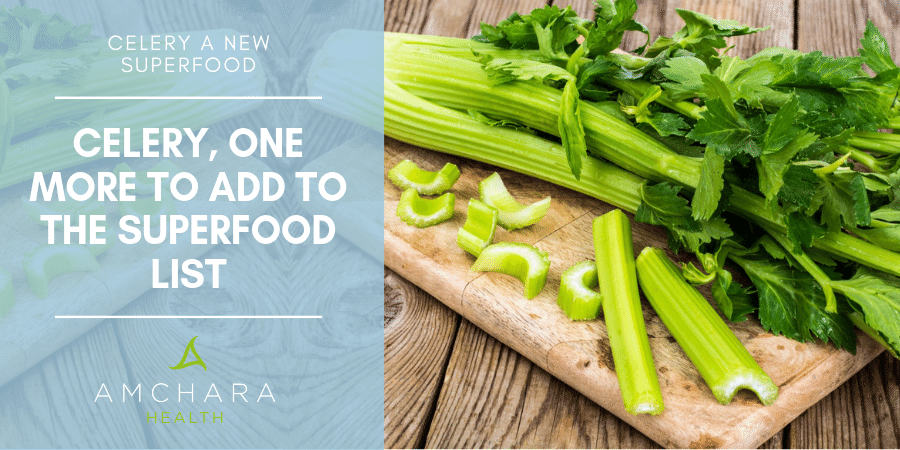Topics Covered in this article:
Celery is rather an acquired taste – you either love it or hate it – a bit like marmite.
If celery’s something you’re not that keen on you might want to find ways to get to love it because it really is quite special in terms of its nutritional and therapeutic value.
All About Celery
Celery (Apium graveolens L) is a plant form the apiaceae family and can be found growing wild in Europe, the Mediterranean region and the tropical and subtropical regions of Africa and Asia.
The Egyptians and ancient Greeks cultivated celery, probably initially for its medicinal properties, later using the leaves for flavouring.
In Greece it was considered a sacred plant and was worn by the winners of the Nemean Games, much like the use of bay leaves at the Olympic games. (2)
Celery also has a long history of use in China, dating as far back as the 6th century AD.
Records for cultivated celery were found in France in 1623. The French chose milder tasting wild plants to be used as vegetables.
At the same time Italy was selecting celery with a large edible tuber.
Both of these types became important in Western temperate areas and many varieties of celery are now grown all over the world.
In India, approximately 40,000 tonnes of celery are produced and more than half of that is exported each year.
For optimal growth celery needs high levels of moisture combined with low temperatures, which means the highest quality celery is often found growing in cold, mild environments.
As a crop, celery is well suited to the UK’s peaty soils and mild climate.
Peat soil is renowned for its water retention properties, the high quantity of water enables the celery to thrive.
Uses for Celery
Celery stalks are generally used in salads, soups and casseroles.
Celeriac, or turnip-rooted celery, is more often used as a cooked vegetable in soups, stews and hot pots but is also becoming popular grated raw in salads.
The leaves of celery have a stronger flavour and are frequently used for garnishing or dried as a seasoning.
Celery is also grown for its seeds – these can be used as a spice, either as whole seeds or ground and added to salt as celery salt.
Nutrients That Make Celery So Special
There’s a good reason why celery is so often included in superfood smoothies and juices – it is jam packed with health promoting compounds.
This has not gone unnoticed, to the extent that some stores in California are struggling to keep up with the demand due to the recent health craze for celery juice. (10)
In nutritional terms, celery is a good source of fibre and has an extensive range of nutrients including:
- vitamin A
- vitamin C
- vitamin D
- vitamin E
- vitamin K
- calcium
- magnesium
- iron,
- zinc
- sodium
- selenium
- potassium
- manganese
- copper
- carotene
- lutein
- zeaxanthin
- betaine
- choline
- thiamine
- riboflavin
- niacin
- folate
It also contains carbohydrates, some protein and a very small amount of fat as well as being naturally low in calories.
The parts of celery that are used therapeutically are the essential oils, leaves and seeds.
Celery has a large range of active constituents (4) that have powerful antioxidant and anti-inflammatory properties including:
- limonene
- selinene
- caffeic acid
- p-coumaric acid
- ferulic acid
- pthalides
- apigenin
- luteolin
- tannin
- saponin
- kaempferol
Research has found that celery seed oil contains 28 different compounds belonging to different categories such as terpenes, sesquiterpenes and their derivatives. (3)
Celery’s fragrance is attributed to the phthalides compounds.
Celery is celebrated by ancient Ayurvedic medicine for its therapeutic value – the presence of compounds such as limonene, flavonoids, alkaloids and vitamins A and C are the reason it is one of the most widely used plants in traditional medicine.
The Secret of Celery’s Rising Superfood Status
Because celery contains such a huge range of biological constituents it is thought to have numerous health benefits.
Celery’s phenolic and antioxidant compounds have been studied extensively by scientists.
Research on rats has found that celery juice is a potent inhibitor of acute inflammation. (5)
This is thought to be due to the luteolin in celery which may be able to inhibit the production of an enzyme that triggers inflammation.
Celery is also believed to act as a mild laxative as well as having diuretic, antiseptic, anti-allergic and wound healing properties.
Original research also suggests celery extract may lower blood pressure. (5)
A good source of fibre, celery could also be seen as a natural way to lower cholesterol levels as fibre attaches itself to excess cholesterol compounds in the gut, and then carries it out of the body via the stools.
Some animal studies have shown that the phthalide constituent in celery seed extract reduces LDL (‘bad’) cholesterol as well as reducing blood pressure. (6)
Other studies go so far as to suggest that antioxidants and flavonoids in celery may help to reduce cancer risk.
Celery’s flavonoids, apigenin and luteolin, have been found to have positive effects against pancreatic and breast cancer. (7)(8)
For those struggling to maintain healthy blood sugar balance celery may be a therapy worth trying.
According to a recent study published in the Saudi Medical Journal, 250mg celery leaf extract taken by 16 participants three times a day was shown to be effective at reducing their blood glucose levels.
Additionally, the essential oils in celery offer promising therapeutic use as antibacterial and antifungal remedies. (9)
Take Home Message
Celery juicing or adding celery to smoothies (if you want the added fibre), is a great way of benefiting from its multiple health benefits.
If you have a condition such as high blood pressure and you would like to try more concentrated therapeutic levels similar to those found in celery seed extract products, it is advisable to do this under the guidance of an experienced Personalised Health practitioner.
You can take advantage of a complimentary consultation with one of Amchara’s qualified Personalised Health practitioners.
Do you like celery? Have you found it has benefited your health?
We’d love to hear from you, please let us know what you think.
READ THIS NEXT:




